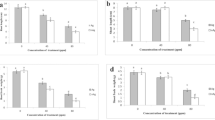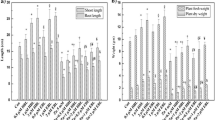Abstract
In the present study, the effects of elevated zinc concentrations on germination, physiological and biochemical parameters were investigated in basil (Ocimum basilicum L.). Results indicate that zinc excess (1–5 mM ZnSO4) did not affect germination process, but it drastically reduced vigor index and radicle elongation, and induced oxidative stress. Exposure of basil plants to 400 and 800 µM Zn decreased aerial parts and roots dry biomass, root length and leaf number. Under these conditions, the reduction of plant growth was associated with the formation of branched and abnormally shaped brown roots. Translocation factor < 1 and bioconcentration factor > 1 was observed for 100 µM Zn suggested the possible use of basil as a phytostabiliser. Excess of Zn supply (> 100 µM) decreased chlorophyll content, total phenol and total flavonoid contents. Additionally, an increased TBARS levels reflecting an oxidative burst was observed in Zn-treated plants. These findings suggest that excess Zn adversely affects plant growth, photosynthetic pigments, phenolic and flavonoid contents, and enhances oxidative stress in basil plants.





Similar content being viewed by others
References
Alonso-Álvarez C, Pérez-Rodríguez L, Mateo R, Chastel O, Viñuela J (2008) The oxidation handicap hypothesis and the carotenoid allocation trade-off. J Evol Biol 21(6):1789–1797
Azzarello E, Pandolfi C, Giordano C et al (2012) Ultramorphological and physiological modifications induced by high zinc levels in Paulownia tomentosa. Environ Exp Bot 81:11–17
Balafrej H, Bogusz D, Triqui ZEA et al (2020) Zinc hyperaccumulation in plants: a review. Plants 9:562. https://doi.org/10.3390/plants900562
Borowiak K, Gąsecka M, Mleczek M et al (2015) Photosynthetic activity in relation to chlorophylls, carbohydrates, phenolics and growth of a hybrid Salix purpurea × triandra × viminalis 2 at various Zn concentrations. Acta Physiol Plant 37:155
Bradford MM (1976) A rapid and sensitive method for the quantitation of microgram quantities of protein utilizing the principle of protein-dye binding. Anal Biochem 72:248–254
Cakmak I, Marschner H (1992) Magnesium deficiency and high light intensity enhance activities of superoxide dismutase, ascorbate peroxidase, and glutathione reductase in bean leaves. Plant Physiol 98:1222–1227
DalCorso G, Manara A, Piasentin S et al (2014) Nutrient metal element in plants. Metallomics 6:1770–1788
Desoky ESM, Elrys AS, Rady MM (2009) Licorice root extract boosts Capsicum annuum L. production and reduces fruit contamination on a heavy metals-contaminated saline soil. Int Lett Nat Sci 73:1–16
Di Baccio D, Kopriva S, Sebastiani L et al (2005) Does gluthatione metabolism have a role in the defence of poplar against zinc excess? New Phytol 167:73–80
Đogić S, Džubur N, Karalija E et al (2017) Biochemical responses of basil to aluminum and cadmium stresses. Acta Agric Serb 43:57–65
dos Santos JO, Andrade CA, de Souza KRD et al (2019) Impact of zinc stress on biochemical and biophysical parameters in Coffea arabica seedlings. J Crop Sci Biotechnol 22:253–264
Fukao Y, Ferjani A, Tomioka R et al (2011) iTRAQ analysis reveals mechanisms of growth defects due to excess zinc in Arabidopsis. Plant Physiol 155:1893–1907
Georgiadou EC, Kowalska E, Patia K et al (2018) Influence of heavy metals (Ni, Cu, and Zn) on nitro-oxidative stress responses, proteome regulation and allergen production in basil (Ocimum basilicum L.) plants. Front Plant Sci 9:Article 862
Hänsch R, Mendel RR (2009) Physiological functions of mineral micronutrients (Cu, Zn, Mn, Fe, Ni, Mo, B, Cl). Curr Opin Plant Biol 12:259–266
Hernandez JA, Almansa MS (2002) Short-term effects of salt stress on antioxidant systems and leaf water relations of pea leaves. Physiol Plant 115:251–257
Hoagland DR, Arnon DI (1950) The water-culture method for growing plants without soil. Calif Agric Exp Station Circ 347:1–32
Hossain MA, Kabir MJ, Salehuddin SM et al (2010) Antibacterial properties of essential oils and methanol extracts of sweet basil Ocimum basilicum occurring in Bangladesh. Pharm Biol 48:504–511
Jain R, Srivastava S, Solomon S et al (2010) Impact of excess zinc on growth parameters, cell division, nutrient accumulation, photosynthetic pigments and oxidative stress of sugarcane (Saccharum spp.). Acta Physiol Plant 32:979–986
Kaur C, Kapoor H (2002) Anti-oxidant activity and total phenolic content of some Asian egetables. Int J Food Sci Technol 37:153–161
Kiferli C, Ascrizzi R, Martinelli M et al (2019) Effect of iodine treatments on Ocimum basilicum L.: biofortification, phenolics, production and essential oil composition. PLoS ONE 14:e0226559
Kosesakal T, Unal M (2009) Role of zinc deficiency in photosynthetic pigment and peroxidase activity of tomato seedlings. IUFS J Biol 68:113–120
Larsson EJ, Asp Bornman H (1998) Influence of UV-B radiation and Cd2+ on chlorophyll fluorescence, growth and nutrient content. J Exp Bot 49(323):1031–1039
Levèbre I, Marchal G, Correal E et al (2009) Variation in response to heavy metals during vegetative growth in Dorycnium pentaphyllum Scop. Plant Growth Regul 59:1–11
Li X, Yang Y, Zhang J et al (2012) Zinc induced phytotoxicity mechanism involved in root growth of Triticum aestivum L. Ecotoxicol Environ Saf 86:196–203
Li X, Yang Y, Jia L et al (2013) Zinc-induced oxidative damage, antioxidant enzyme response and proline metabolism in roots and leaves of wheat plants. Ecotoxicol Environ Saf 89:150–157
Lichtenthaler H, Wellburn AR (1983) Determinations of total carotenoids and chlorophylls a and b of leaf extracts in different solvents. Biochem Soc Trans 11:591–592
Mahmoudi H, Marzouki M, M’Rabet Y et al (2020) Enzyme pretreatment improves the recovery of bioactive phytochemicals from sweet basil (Ocimum basilicum L.) leaves and their hydrodistilled residue by-products, and potentiates their biological activities. Arab J Chem 13:6451–6460
Marichali A, Dallali S, Ouerghemmi S et al (2014) Germination, morpho-physiological and biochemical responses of coriander (Coriandrum sativum L.) to zinc excess. Ind Crops Prod 55:248–257
Marichali A, Dallali S, Ouerghemmi S et al (2016) Responses of Nigella sativa L. to zinc excess: focus on germination, growth, yield and yield components, lipids and terpenes metabolisms, total phenolics and antioxidant activities. J Agric Food Chem 64:1–42
Mau JL, Chao GR, Wu KT (2001) Antioxidant properties of methanolic extracts from several ear mushrooms. J Agric Food Chem 49:5461–5467
McCall KA, Huang CC, Fierke CA (2000) Function and mechanism of zinc metalloenzymes. J Nutr 130:1437S-1446S
Morina F, Jovanović L, Kukavica B et al (2008) Peroxidase, phanolics, and antioxidative capacity of common mullein (Verbascumthapsus L.) grown in a zinc exess. Arch Biol Sci 60:687–695
Nowak J, Frérot H, Faure N et al (2018) Can zinc pollution promote adaptive evolution in plants? Insights from a one-generation selection experiment. J Exp Bot 69:5561–5572
Pandey AK, Singh P, Tripathi NN (2014) Chemistry and bioactivities of essential oils of some Ocimum species. An overview. Asian Pac J Trop Biomed 4:682–694
Prasad KVSK, Saradhi PP, Sharmila P (1999) Concerted action of antioxidant enzymes and curtailed growth under zinc toxicity in Brassica Juncea. Environ Exp Bot 42:1–10
Prasad A, Kumar S, Khaliq A et al (2010) Heavy metals and arbuscular mycorrhizal (AM) fungi can alter the yield and chemical composition of volatile oils of sweet basil (Ocimum basilicum L.). Biol Fertil Soils 47:853–861
Prieto P, Pineda M, Aguilar M (1999) Spectrophotometric quantitation of antioxidant capacity through the formation of a phosphomolybdenum complex: specific application to the determination of vitamin E. Anal Biochem 269:337–341
Rout GR, Das P (2003) Effect of metal toxicity on plant growth and metabolism: I. Zinc Agronomie 23:3–11
Shi G, Cai Q (2009) Cadmium tolerance and accumulation in eight potential energy crops. Biotechnol Adv 27:555–561
Siedlecka A, Tukendorf A, Skorzynska-Polit E, Maksymiec W, Wojcik M, Baszynski T, Krupa Z (2001) Angiosperms (Asteraceae, Convolvulaceae, Fabaceae and Poaceae; other than Brassicaceae). In: Prasad MNV (ed) Metals in the environment. Analysis by biodiversity, pp 171–217. Marcel Dekker Inc., New York, Basel
Srinivas ND, Rshami KR, Raghavarao KSMS (1999) Extraction and purification of a plant peroxidase by aqueous two-phase extraction coupled with gel filtration. Process Biochem 35:43–48
Subba P, Mukhopadhyay M, Mahato SK et al (2014) Zinc stress induces physiological, ultrastructural and biochemical changes in mandarin orange (Citrus reticulata Blanco) seedlings. Physiol Mol Biol Plants 20:461–473
Subhashini V, Swamy AVVS, Hema Krishna R (2013) Pot experiment: to study the uptake of zinc by different plant species in artificially contaminated soil. World J Environ Eng 1:27–33
Torasa S, Boonyarat P, Phongdara A et al (2019) Tolerance mechanisms to copper and zinc excess in Rhizophora mucronata Lam. Seedlings involvecell wall sequestration and limited translocation. Bull Environ Contam Toxicol 102:573–580
Wang C, Zhang SH, Wang PF et al (2009) The effects of excess Zn on mineral nutrition and antioxidative response in rapeseed seedlings. Chemosphere 75:1468–1476
Wei Y, Guo M (2014) Zinc-binding sites on selected flavonoids. Biol Trace Elem Res 161:223–230
Yemm E, Willis A (1954) The estimation of carbohydrates in plant extracts by anthrone. Biochem J 57:508–514
Youssef NA (2020) Changes in the morphological traits and the essential oil content os sweet basil (Ocimum basilicum L.) as induced by cadmium and lead treatments. Int J Phytoremediat. https://doi.org/10.1080/15226514.2020.1812508
Zhishen J, Mengcheng T, Jianming W (1999) The determination of flavonoid contents in mulberry and their scavenging effects on superoxide radicals. Food Chem 64:555–559
Zoufan P, Karimiafshar A, Shokati S et al (2018) Oxidative damage and antioxidant response in Chenopodium murale L. exposed to elevated levels of Zn. Braz Arch Biol Technol 61:e18160758
Author information
Authors and Affiliations
Corresponding author
Ethics declarations
Conflict of interest
The authors declare that there is no conflict of interest.
Additional information
Publisher's Note
Springer Nature remains neutral with regard to jurisdictional claims in published maps and institutional affiliations.
Rights and permissions
About this article
Cite this article
Mahmoudi, H., Salah, I.B., Zaouali, W. et al. Impact of Zinc Excess on Germination, Growth Parameters and Oxidative Stress of Sweet Basil (Ocimum basilicum L.). Bull Environ Contam Toxicol 106, 899–907 (2021). https://doi.org/10.1007/s00128-021-03188-6
Received:
Accepted:
Published:
Issue Date:
DOI: https://doi.org/10.1007/s00128-021-03188-6




